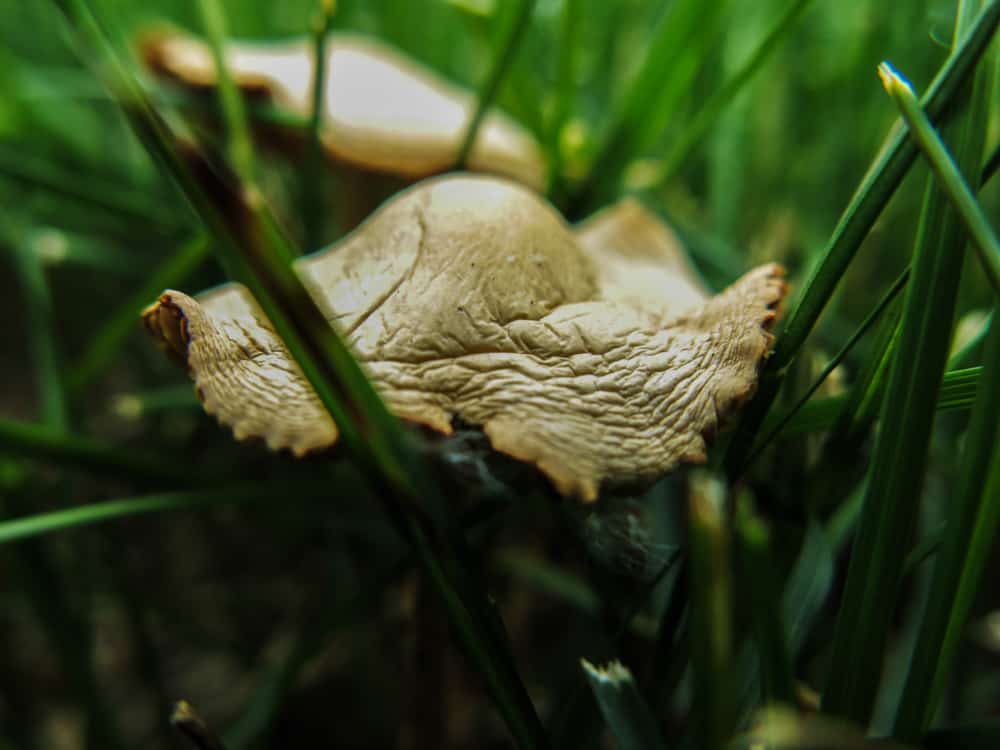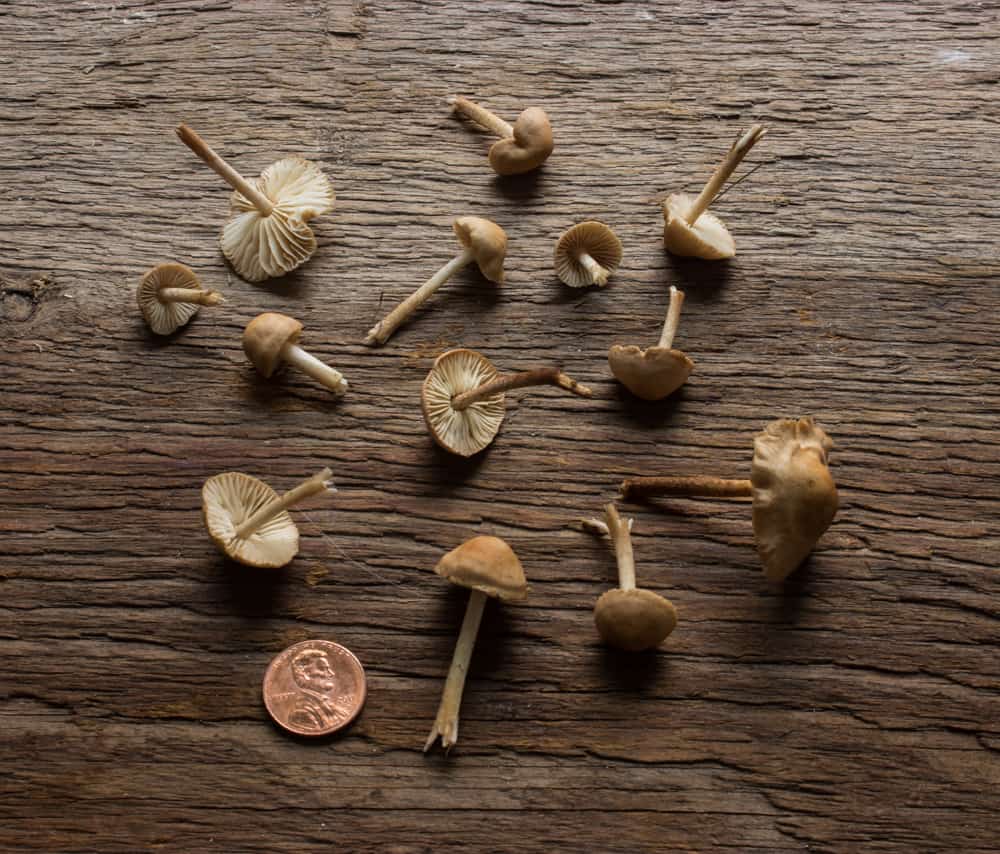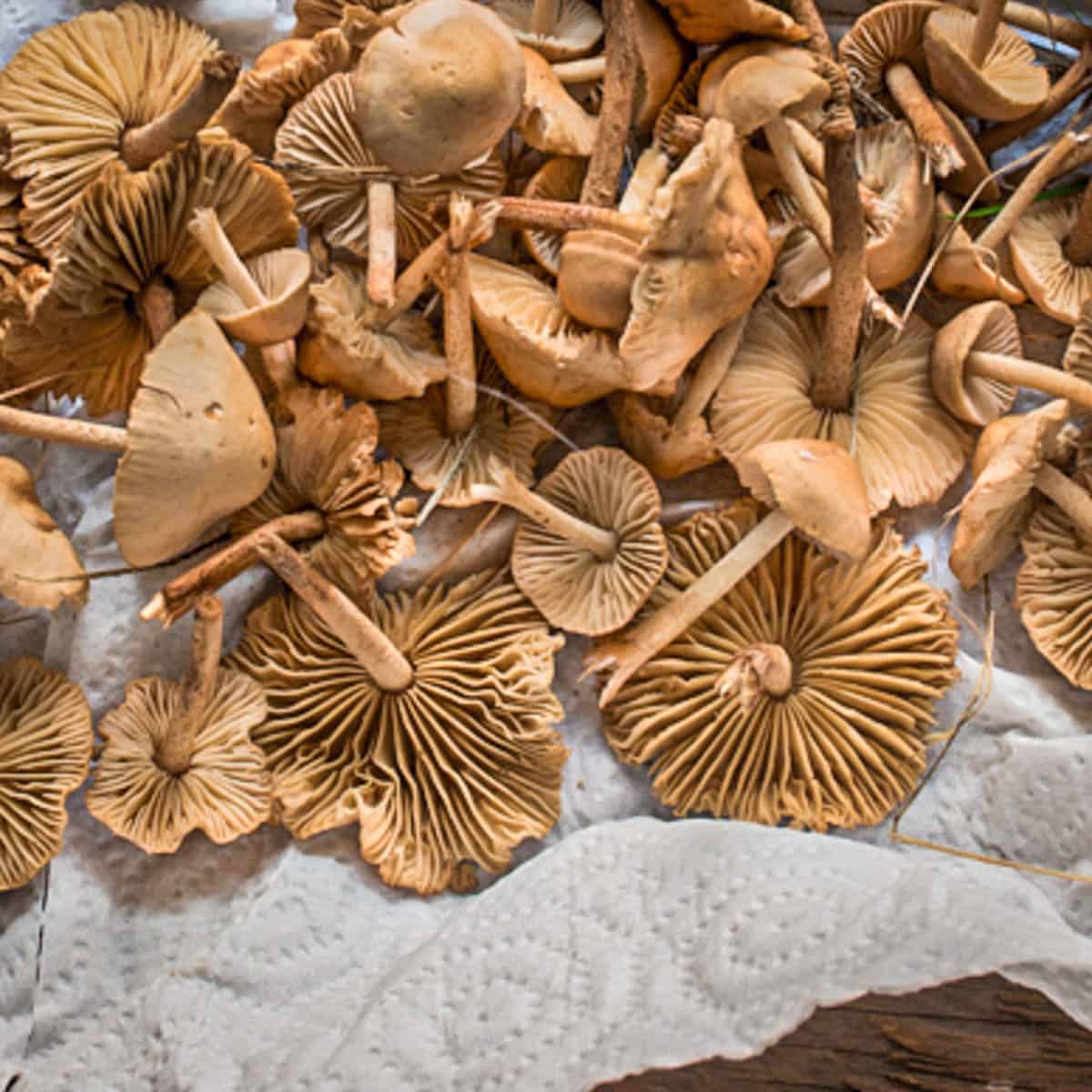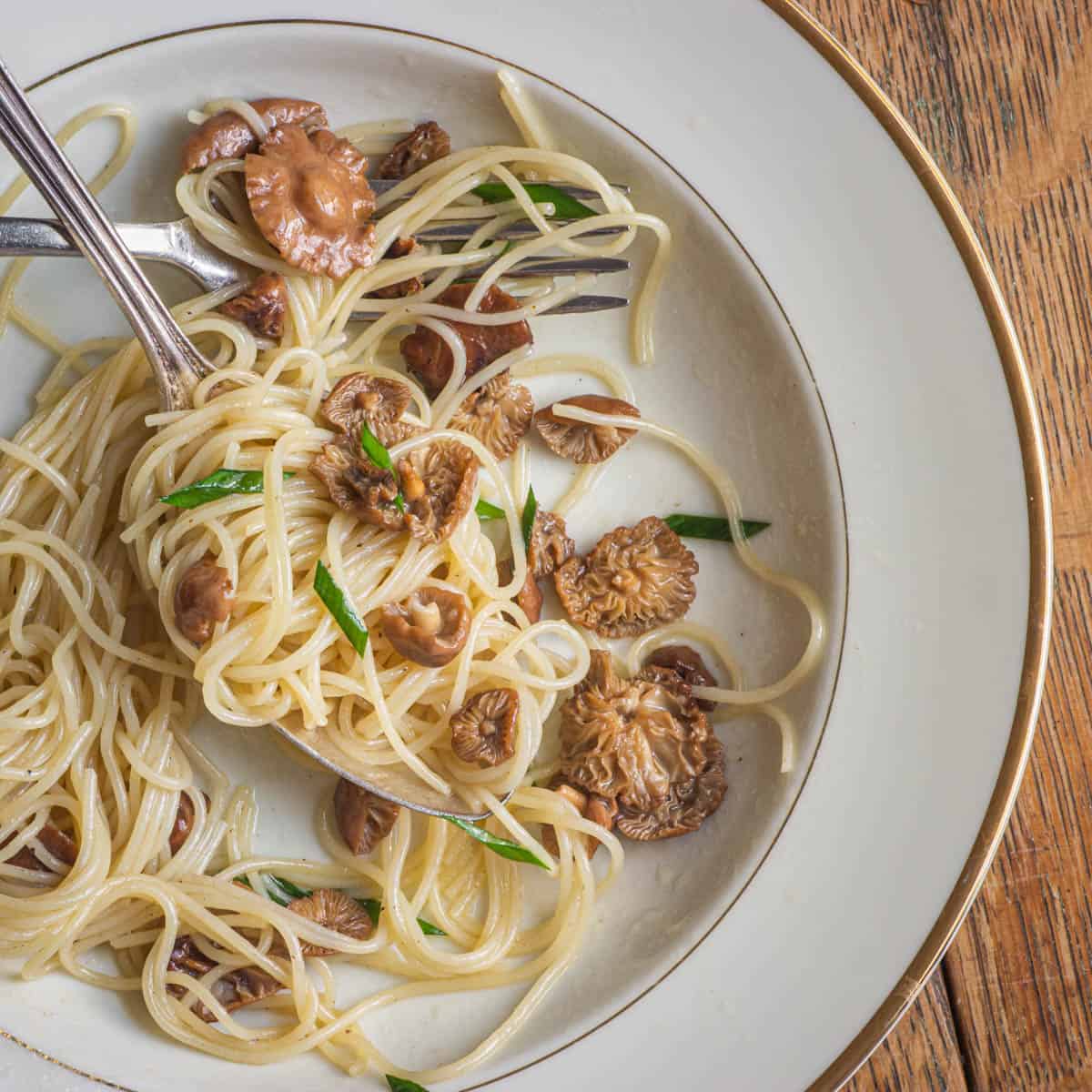We've all been told not to eat little brown mushrooms growing in the yard. Fairy ring mushrooms, or mousserons in French (Marasmius oreades) are the exception. They're small, but they pack big flavor. Once you find a little patch you can come back to the same spot to pick more each year.

Small mushrooms are hard to identify, but there's characteristics that make these easy to pick out, as long as you pay attention.
Where to Find Fairy Ring Mushrooms
Along with Agaricus campestris and others, these are one of the most common edible yard mushrooms.
The name fairy ring is misleading as many mushrooms grow in a naturally occurring ring pattern and could be called fairy ring mushrooms. Most of the time I see these in a definite ring. I pick them around the crater of a stump that's been removed in the "brulee" or dark ring of dead grass that lets you know some type of fungus is growing, taking nutrients from the grass and organic matter.
The habitat is important for a correct ID, and you won't find these in the deep woods. These like sunny, open areas, grassy areas, outer edges of pastures, yards, and meadows. I usually start to see them in Minnesota around mid June.

Fairy ring mushrooms in the front yard in rings of grass. I always see them around the area a stump was removed from every year. Note the bell shaped cap.
Fairy Ring Mushroom Identification
The fruiting bodies are small, with caps usually 1-2 inches across. For me, the easiest way to identify fairy rings is their stem.
The stem is tough and pliable, you can bend it back and forth and it won't budge, in fact, you have to be careful when removing the stems for cooking these, since the cap will tear with it if you use too much force.
There's a lot of mushrooms that can look like these, but most of the other ones have stems that are brittle, or snap off easily when bent.
Then there's the cap, the fairy rings that I pick usually have an umbonate, or bell shaped cap. When I show it to people, I usually describe it as looking like a nipple, which seems to help.

Very young fairy rings may not have the nipple shaped cap.
The gills are unique. Fairy rings generally have more widely spaced gills than other similar looking yard mushrooms. The gills also fork, meaning some of the gills won't connect with the stem.

Note some of the gills don't connect with the stem, and some are forked.
Here's a recap on fairy ring ID:
- White spore print
- Typically have a nipple shaped cap
- Have a tough, pliable stem
- Generally grow in rings
- Have gills that will fork and may not attach to the stem
Cooking Fairy Ring Mushrooms
The first thing to do is remove the stems and leave the cap in one piece. Grab the stem, twist gently and it will pop off.
As far as cleaning, these aren't usually dirty or buggy. If they have grass or debris stuck to them, I rinse them in some cold water and then allow them to dry between a few layers of towels in the fridge.

Preservation is easy, if you leave them out on a counter they may dry naturally. I like to use a dehydrator. While they're growing in open areas, they can get dried out and shriveled by the sun, but they come completely back to life after a rain.

Here's my favorite fairy ring mushroom recipe. I like to keep it simple with these.
Capellini With Fairy Ring Mushroom Sauce
Equipment
- 1 Pasta pot
- 1 10 inch saute pan
Ingredients
- 2 ounces fairy ring mushroom caps cleaned
- 4 ounces dried angel hair pasta my favorite brand is Rustichella d'Abruzzo
- 1 tablespoon shallot diced ⅛ in
- 3 tablespoons unsalted butter
- ⅛ cup dry white wine
- ½ cup chicken or other poultry stock preferably homemade
Instructions
- Bring a few quarts of salted water to a simmer. Meanwhile, in a separate pan, heat 2 tablespoons of the butter on medium heat.
- Add the fairy rings to the pan and cook for a few minutes to brown them, then season with salt and pepper. Add the wine and cook for 2-3 minutes, then add the chicken stock. Bring the water to a boil, add the pasta and stir thoroughly to prevent clumping.
- Cook the pasta to al dente, then add to the pan with the mushrooms.
- Cook the mixture for another minute or two, add the remaining butter and stir to make a creamy sauce, finish with the garlic chives at the last minute, double check the seasoning for salt and pepper then divide the pasta between two warmed bowls and serve immediately.


Peter
Hi, Alan. I have been finding and harvesting lots of these this summer in a park near where I live. I've read some places that they start producing cyanide soon after picking, and therefore must be prepared as soon as possible. In line with this knowledge, and since marasmius technically are defined by their dehydration resistance, I've been giving them the same shameful treatment as I would to red leccinums to make sure, cooking them (although not for as long) and then dehydrating them as I just now described in a reply to your entry about these.
Do you have any experience dehydrating fairy ring mushrooms, and if so, do you have any knowledge on whether dehydrating alone would be enough to hinder cyanide production? Again, thank you for sharing your knowledge.
Alan Bergo
Hi Peter, I dry fairy ring mushrooms quickly after I pick them since they're so small and they can dry out quickly in the fridge. I can't speak to the containing cyanide. They can be dried simply by threading on a string and putting them out in the sun and wind, or dry them in a dehydrator at anywhere from 100F-145F for a couple days. I've never had an issue drying them, I think of them as one of the easiest to dehydrate since they're small and thin, like black trumpet mushrooms.
Kayla
I used morels for this recipe and it was absolutely delicious!!
Alan Bergo
Hey thanks Kayla, glad it worked for you.
CHRISTINE
I found these mushrooms all over the yard in several lose rings, but most are bigger than typically described—anywhere from 1in to 4in diameter. Spore prints are all white! I plan on sautéeing a few tomorrow with with scrambled eggs for breakfast. I think I'll live.
Alisa Greenhill
You give recipes for fairy after which in the first line you you say, "don't eat them or you'll be sorry." This makes no sense to me. Please explain.
Alan Bergo
When I say "little brown mushrooms" I am not referring to the edible mushrooms in this post. Little brown mushrooms or "LBMs" as they're known in mycological speak are not Marasmius oreades (the mushroom I'm profiling here), but some amateurs might confuse them as such. I would suggest you read up and familiarize yourself with some scientific mushroom names. These are not a beginner mushroom.
jamesfedrick
A great piece of information. Thanks for the information on how the gills fork. Super helpful-I have a bunch in my yard I'm looking forward to trying.
Dave T
M. oreades are not always tiny little mushrooms. We have recurring fruitings of these delicious shrooms in our yard every year and some specimens have caps up to 5" in diameter! Most are 1 to 3". We usually eat them fresh, sauteed in olive oil with a little garlic and mirin and folded into omelets. I really should try to dry some just to experience their miraculous rebirth when re-hydrated.
cacarr
These are delicious little mushrooms, and surprisingly substantial for their size. I like to sautee them at a high enough temperature that they get a bit crispy (they almost seem to caramelize like onions) -- at which point they are reminiscent of bacon. 🙂
Luis
🙂 trying our first ones tonight - came across them in the local park yesterday. They do taste a little like bacon we have to admit. They're such a find!
Thanks for the website Alan..
Take care
Kerstin and Luis
New Zealand
Alan Bergo
Enjoy.
Myra Weeks
I have a fairy ring! Actually it’s not a complete ring as it curves into the bricks of the corner of my house. These are a total surprise, it’s been freezing cold since they’ve appeared, day and night. The lovely ring is gracing the northwest corner, mostly totally shaded. I was looking out the window one morning to see what had the interest of my cat, and saw the semicircle ring of light putty colored growths that from the window look as if they could be gravel from a road, or driveway. I’m thrilled with them being there, but I was surprised to see these had popped up with the temperatures had plummeting down to freezing. I read somewhere that these are sometimes called spider rings, am I correct? That’s fine with me as well. I don’t use pesticides, just naturals that include chalk around doors, bay leaf thrown into cabinets, that sort of thing. So I’ve had permanent resident golden orb weavers, much to my delight. I’m not strange, just a reformed arachnophobia case, do as long as they’re helpers. And they’re safe in lodging from my patio, above my huge rosemary that’s taken over almost half my patio. It blooms as often as six times a year, maybe a couple more small stress blooms. I’ve had some health problems that have kept me in so I’ve not been outside to look at my nice fairy ring, spider ring, so I’ve not seen the underside of the fungi but they appear to be almost sitting on the grass, like a ring of rocks, part of a medicine wheel kind of. I’m just taken with them popping up in freezing and below freezing temps, day three or four, five? I’m not sure. I just wondered why winter would spur on the growth, and what do I do to make sure they return as often as possible. Thank you so much.
Myra, and Bailey Kitty ???? Kat, owner and proprietor ~~~Best wishes to all from our home, always!~~~
Alan Bergo
Where are you located? During this time of year I'd be skeptical of M. oreades growing. Many mushrooms grow in fairy rings.
Myra Weeks
I’m in northwest Alabama. The ring is still producing but I’ve not gone outside yet to look at it. It’s quite large, but it’s not a complete ring because of it going against the corner of the house on two sides of the house. My health is somewhat dodgy and I am not able to get around. The weather has been raining off and on and the winds are dipping into near freezing temps during the day early mornings and late afternoons. Would there have been a tree there at some point? I do know that thes houses along this streeet are around twenty to twenty five years old. Thank you for your time! I like your website and am glad to have found you. Thank you again, my best to you and yours this holiday season!
Myra Weeks
Hello, and Season’s Greetings!
I looked at my fairy ring that I asked about when I first emailed and discovered it’s larger than I realized, about 8-9 feet. I discovered that there are actually two, one inside the other. In several places they are in thick clumps, tightly packed together which is why at first thought they were stones. But I rarely get out so it’s not surprising. They are all the same height at their tallest, two inches. They’re growing on a north side, shaded most all the time, even those circling around to the west side. The corner of the house intruded into the ring. With some taller oak trees close.If there is nothing to add as far as information other than you’ve already kindly provided for me then there’s no reason to bother taking time on your part with a return on this. I have no questions, I just thought I would pass along this as a closer for my previous email/emails. Thank you so much, I never knew until recently what fairy rings actually are. I was excited to see one, a double maybe, right here under my nose.????????♂️????????♀️Have a blessed Holiday Season, everyone!
Stella Phipps
Have you ever noticed a slight bitter flavor if overcooking them in butter?
Alan Bergo
No, but it's definitely possible.
Renee west
Yes, I definitely notice a slight bitter flavor as I have cooked them probably too long. I've been focused on making sure my mushrooms are well cooked since I'm more of a novice mushroom picker. I am a little afraid of undercooking but wondering what the ideal cooking is for marasmius to keep them not bitter.
Ben
I ate one raw right from the ground. Brushed off any soil/organic material and ate the first time that I found out what it was. Good.
Ben
I picked the Fairy Ring Mushrooms on a ranch in Glennville Ca last Sunday the 31st of December.
Alan Bergo
Haven't tried that!
Sam Schaperow
Tried finely chopping stems for use in recipes?